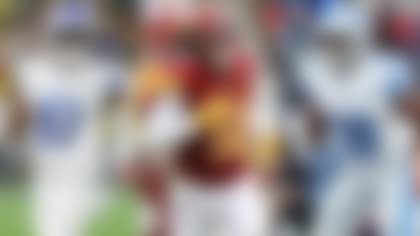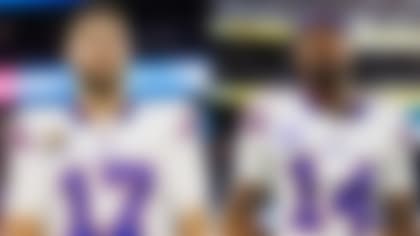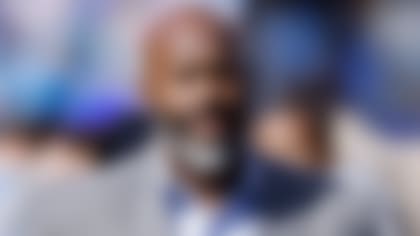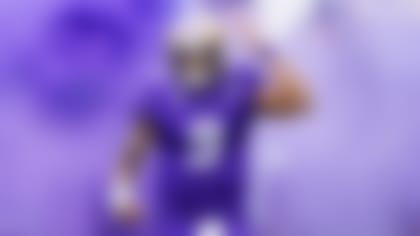Picking up where I left off with yesterday's look at the NFC teams and their red zone scoring/efficiency, today's piece dives deep into the red zone work of all 16 AFC teams.
As a refresher from yesterday, on average, NFL teams run 132 plays in the red zone and convert just over 20 percent of said plays into touchdowns, for a league average of about 26 red zone touchdowns per team. Overall, there was a .595 correlation between red zone touchdown percentage and offensive scoring, which should come as no surprise to most football fans. Scoring touchdowns as opposed to field goals in the red zone will lead to more points, but there are obvious outliers such as big plays and long touchdowns. A .595 correlation isn't outrageous by any means (if it had been .7 or higher we'd really be in business), but it's positive enough to draw the rather obvious conclusion that it'd behoove us to lean toward drafting players who could have increased opportunities in the red zone in more efficient offenses.
Baltimore Ravens
The Baltimore skill position groups are among the most puzzling and difficult to figure out in the NFL currently, and that holds true in the red zone. With several players returning from injury (Steve Smith, Justin Forsett, Breshad Perriman, Crockett Gillmore) and new arrivals (Benjamin Watson, Mike Wallace) muddying the picture, it's tough to ascertain much based on 2015's numbers. Looking at the running game, Justin Forsett figures to get the early-season looks in the red zone, but both he and Javorius Allen weren't particularly efficient with their touches there last year. If Kenneth Dixon makes a splash in training camp and the preseason, perhaps he gets some looks. Otherwise, it'll be hard to trust any reliable red zone production from this team until we see a trend emerge on the field.
Offensive coordinator Marc Trestman passes on nearly 60 percent of his red zone plays, based on his last three years in the NFL (with Baltimore and Chicago). Surprisingly, Kamar Aiken was the Ravens' most reliable red zone threat last year, converting 50 percent of his targets into touchdowns (4-of-8). Steve Smith only hauled in one of his nine targets in the red zone, but was never a monster in that space (converted 17 percent of his targets into touchdowns from 2011-2014). The biggest question marks will be Mike Wallace and Breshad Perriman. Will Wallace recapture his 2014 form, when he hauled in nine touchdowns on 19 targets in the red zone for Miami? Or has he become a journeyman, on his third team in three years? Likewise, what role, if any, will last year's first-round pick Breshad Perriman have in the red zone as he battles back from a partially torn ACL this offseason? Questions like this are why Baltimore's skill position players aren't being drafted too highly in early mock and real drafts.
Buffalo Bills
The Rex Ryan-led, Tyrod Taylor-quarterbacked Bills were the run-heaviest team in the red zone last year, with just over 60 percent of their plays coming on the ground. This didn't net many touchdowns for LeSean McCoy, though that could be an anomaly. However, the Taylor and Karlos Williams vulture opportunities still lurk, which those hoping to draft Shady will have to keep in mind. Taylor's running ability helps give him a safe floor as a late-round quarterback option, in addition to passing numbers that helped him complete two solid fantasy scoring streaks in 2015.
Passing-wise, this offense doesn't really have a true red zone threat, as Sammy Watkins, Chris Hogan and Robert Woods split up the targets pretty evenly. If Watkins can rebound from his offseason foot surgery, perhaps he sees a few more looks in that space, but over his first two seasons he's seen roughly 15 percent of the red zone targets, which is hardly a reliable market share to project. That being said, Watkins is one of the best deep threats in the league and doesn't need red zone opportunities to keep his fantasy production afloat.
Cincinnati Bengals
The Bengals found a lot of success in the red zone in 2015, with A.J. Green, Tyler Eifert and Jeremy Hill converting a high number of their opportunities into scores. In the passing attack, 19 red zone targets left the team in free agency with Marvin Jones and Mohamed Sanu, but those will likely trickle mostly back to Green and Eifert, with rookie Tyler Boyd and Brandon LaFell fighting for scraps. It's worth noting that Jones and Sanu only scored twice on those 19 chances last season.
On the ground, Jeremy Hill and Giovani Bernard split up touches pretty evenly, with Hill having a slight edge at 39 to Bernard's 32. The bigger discrepancy, though, comes when the team is approaching the goal line, as Hill received 24 carries inside the 10 yard line to Bernard's 14. That's largely why Hill scored 10 touchdowns on the ground last year to Bernard's two. Projecting this split for 2016, not much figures to change. Hill will likely be the goal-line back, while Bernard will be used between the 20 and 10 yard lines. Bernard is already being pegged as a sleeper by plenty of analysts, and if he earns a few more red zone opportunities based on his efficiency in that space (4.7 yards per carry in 2015) he could become even more of a steal with a few extra touchdowns.
Cleveland Browns
Surprising no one, the Browns were a disaster in the red zone in 2015. While they ran the seventh-most plays inside the 20, their 12.1 touchdown percentage was the worst in the league, and the second-worst of all the teams I profiled in this four-year sample. Hue Jackson loves to run the football, so the team could swing back more to a run-heavy approach in the red zone after four straight years of passing dominating their red zone plays. That's good news for Duke Johnson and Isaiah Crowell, both of whom currently have late-round fantasy value.
Through the air, Gary Barnidge was a vaccum for red zone looks with 23 targets and eight of his nine touchdowns coming in this space. Assuming he's fully healthy after offseason sports hernia surgery, he figures to once again lead the way in the red zone. After that, there is plenty of opportunity for rookie Corey Coleman, as 28 targets are now open with the departures of Travis Benjamin, Brian Hartline and Dwayne Bowe.
Denver Broncos
With Peyton Manning's play falling off in 2015, so too did the team's red zone volume and efficiency. That trend could continue in 2016, as the team will likely be starting Mark Sanchez, Trevor Siemian or rookie Paxton Lynch under center. That could spell a more run-heavy approach this year, which is good news for C.J. Anderson's attempt at a bounce-back campaign after a fantastic post-season run. Ronnie Hillman received more looks and scored more touchdowns in the red zone in 2015, but this should be Anderson's backfield this year unless rookie Devontae Booker shows up in a big way early.
Demaryius Thomas saw nearly 28 percent of the targets in the red zone in 2015, but only scored three touchdowns. Emmanuel Sanders also scored three times, but on just eight targets. These two should own most of the red zone looks, but someone will need to step up at tight end to fill the void left by the recently released Owen Daniels. That will be a training camp battle to watch between Jeff Heuerman, Garrett Graham and Virgil Green.
Houston Texans
The Texans offense was a mess aside from DeAndre Hopkins in 2015. With Arian Foster suffering another season-ending injury, the red zone backfield touches were divvied up between the motley crew of Alfred Blue (20 rushes, one catch), Jonathan Grimes (seven rushes, five catches), Chris Polk (six rushes, one catch) and Akeem Hunt (three rushes). With the team signing Lamar Miller on a big deal this offseason, most of that work will likely fall onto his shoulders. Bill O'Brien gave around 64 percent of the backfield red zone opportunities to a healthy Foster in 2014, so it's fair to expect a similar share to go Miller's way in 2016. Rookie Tyler Ervin could get into the mix as well, especially on specialty plays and screens, but his workload shouldn't be a real threat to Miller's volume.
Brian Hoyer was efficient in the red zone last year, throwing 14 touchdowns with no interceptions (on 43 attempts) and completing around 56 percent of his passes. It helps when you're mainly targeting DeAndre Hopkins (22 targets, 12 catches, six touchdowns). Nuk should remain the No. 1 option near the end zone, as incoming rookies Will Fuller and Braxton Miller don't specialize in this space. Nate Washington's 13 targets will be up for grabs, though, as he's now in New England. It'll be worth watching how Brock Osweiler jells with his new pass-catchers after joining Houston this offseason. He was slightly less efficient than Hoyer last season (seven touchdowns on 35 attempts, 51.4 completion percentage), but working under Bill O'Brien and with Hopkins could help him out.
Indianapolis Colts
The 2015 season was certainly one to forget for the Colts, as injuries and age waged war on their productivity. Frank Gore saw 70 percent of the carries the red zone, but only found pay dirt twice on 35 attempts. The team still doesn't have much depth behind him, so until Gore finally falls victim to Father Time he'll have a sizeable workload in the Colts offense and the red zone moving forward.
While Andrew Luck had his fair share of struggles last year, operating in the red zone wasn't among them. Luck completed almost 64 percent of his red zone attempts, scoring a touchdown on 31 percent of his passes (11 total) with just one interception. Donte Moncrief was the most efficient wideout in the red zone, and he could be in line for even more work with Andre Johnson and his 11 targets (five catches, four touchdowns) out of the way. Moncrief has the size and athleticism to be a more dominant force around the end zone than T.Y. Hilton, who led the team in red zone targets last year with 15. With Coby Fleener now in New Orleans, Dwayne Allen should own the vast majority of the red zone targets at tight end. Fleener was inefficient with his looks last year (two touchdowns on 11 targets), so Allen could have a chance to surprise in that space this year.
Jacksonville Jaguars
After three years of terrible red zone efficiency and production, the Jaguars saw a big boost in 2015 thanks to the emergence of Blake Bortles and Allen Robinson. The running game was still awful, though, as the backs managed just two touchdowns on 44 attempts in the red zone. T.J. Yeldon was the biggest culprit, with 22 attempts for 63 yards and just one score, while Denard Robinson found the end zone once on his 13 attempts. This explains the offseason acquisition of Chris Ivory, who converted six of his 38 red zone attempts into touchdowns in 2015 and has the physicality to be a beast near the goal line. His presence puts a lower ceiling on Yeldon's fantasy potential next year, as he'll likely have to score from distance.
Allen Robinson was a major reason why the Jaguars scored 17 more touchdowns in the red zone in 2015 than they did in 2014. He converted 12 of his 14 receptions into touchdowns off 21 targets, and should be the primary option again in 2016. Julius Thomas only saw nine targets during an injury-plagued season, but that number could rise this year as he and Bortles are working on getting on the same page. Allen Hurns (13 targets in 2015) will be in the mix as well, but will likely be lower in the pecking order than Robinson and probably Thomas, too.
Kansas City Chiefs
2015 ended up as a bit of a mess for the Chiefs in the backfield once Jamaal Charles went down with a torn ACL, as Charcandrick West and Spencer Ware were left to split up his touches. Ware was the much more effective red zone back, turning six of his 12 attempts into touchdowns compared to just three of 22 for West. Charles punched in three of his eight attempts pre-injury, and should return as the top option under Andy Reid this year, though don't be surprised if the bruising Ware vultures a few goal-line scores.
The Kansas City passing attack was comprised largely of two players in the red zone -- Jeremy Maclin (13 targets) and Travis Kelce (10 targets). They accounted for 10 of Alex Smith's 14 red zone touchdowns, and figure to once again lead the way for this offense in 2016.
Miami Dolphins
After running the most red zone plays in the league in 2014, the Miami offense crashed back to Earth in 2015. Lamar Miller's backfield touches are up for grabs, with Jay Ajayi looking to be the primary recipient. Kenyan Drake could siphon off some passing down work, but Ajayi should see the majority of attempts near the goal line, further cementing him in the RB2 range for drafts this fall.
Jarvis Landry emerged as a target hog for the Dolphins in 2015, commanding over 32 percent of the red zone looks from Ryan Tannehill. The next closest player was actually Jordan Cameron (21 percent), who could have deep sleeper potential this year after a disastrous first season in Miami. DeVante Parker figures to get into the mix more as well now that he's fully healthy, as he only saw eight targets as a rookie (one catch, one touchdown).
New England Patriots
It should surprise no one that the Patriots have been one of the most effective teams in the red zone over the last four years. The team has finished in the top four in offensive scoring each year in that span thanks to Tom Brady's surgical precision when it counts. Injuries to Dion Lewis and LeGarrette Blount likely led to the team skewing more pass-heavy in 2015, but that should even back out with both backs once again healthy. Blount will eat up many of the goal line carries (that Brady doesn't take himself), while Lewis should figure in more heavily in the passing game.
Speaking of, when the Patriots approach the end zone, the main number getting called is 87. Rob Gronkowski has had at least 16 targets and seven touchdowns in the red zone in three of the last four years. If Julian Edelman can get back up to full health, he'll be option No. 2, as his elite short-area quickness makes him a nightmare to cover near the goal line. Brandon LaFell and Scott Chandler's combined 16 targets are up for grabs, and Chris Hogan or Martellus Bennett could make a play for the majority of those. The 6-foot-6 Bennett might have the early lead, though, but owners shouldn't overdraft him on that hypothesis alone.
New York Jets
Chris Ivory dominated the Jets backfield touches in the red zone, and now that role will likely go to the recently acquired Matt Forte. Khiry Robinson lurks as a potential touchdown vulture, though, as Forte has never been a great goal-line back. Still, the volume will be there if Forte can fend off Father Time for another year.
Through the air, Eric Decker and Brandon Marshall are all that matters in this offense. Decker led the way with 12 catches and 10 touchdowns on 28 targets, with Marshall not far behind with 11 catches and nine touchdowns on 21 targets. Even if Geno Smith is starting under center instead of Ryan Fitzpatrick, these are two excellent football players with safe volume. Don't overthink it on draft day when it comes to Decker and Marshall. Their 74 combined red zone touchdowns since 2010 are the most in the NFL in that span.
Oakland Raiders
The Raiders needed help in the backfield after last year, which is part of the reason they drafted DeAndre Washington this spring. The Raiders relied heavily on Latavius Murray (33 rushes), and he punched in five touchdowns from six yards or closer, but didn't receive a target in the passing game. Washington could replace the role in the passing game the team attempted to cobble together between Roy Helu and Marcel Reece, but for now Murray will be the primary beneficiary of red zone and goal line opportunities.
Derek Carr preferred Michael Crabtree (13 targets) to Amari Cooper (seven targets) as the team approached the end zone in 2015, but both had three catches and two touchdowns on the year. With Cooper already getting hyped as taking another step this offseason, it wouldn't be a surprise to see him earn more looks in 2016 and even outproduce Crabtree in the red zone. Clive Walford saw just seven targets last year in this space, but could steal more work from Mychal Rivera in 2016 after building a solid rapport with Carr down the stretch last year.
Pittsburgh Steelers
The rushing numbers for the Steelers are skewed from last year, as Le'Veon Bell once again suffered a season-ending injury and DeAngelo Williams had a career-year filling in. It remains to be seen if the team will rotate in Williams to keep Bell more fresh in 2016, but if recent history is any indication this will be Bell's backfield as the team approaches the end zone. In 2013 and 2014, Bell owned over 82 percent of all the red zone backfield opportunities (carries and targets). He's too talented of a back to not have on the field in scoring situations, so owners shouldn't be too afraid of Williams vulturing touchdown chances from Bell.
Everything in the Pittsburgh passing attack starts with Antonio Brown, and he should once again command a large share of the red zone targets in 2016 (he had 23 in 2015). Martavis Bryant's 13 targets will likely be split up in some way between Markus Wheaton (15 in 2015) and Ladarius Green. Heath Miller had 13 targets last year, so if Green can jell quickly with Ben Roethlisberger he could be come a red zone monster in this offense (he scored three times on eight targets last year in San Diego).
San Diego Chargers
The Chargers have been in search of a featured back since LaDainian Tomlinson hung up his cleats, and that can be seen in how they've skewed more heavily toward the pass in the red zone in each of the last four years. With Melvin Gordon working his way back from offseason microfracture surgery, the goal-line carries could be few and far between. He didn't score once on 11 chances in the red zone last year, while Danny Woodhead found paydirt on three of his 19 attempts. Woodhead also saw 15 targets (most on the team), though that number figures to dip a bit with the return of a healthy Keenan Allen and Antonio Gates. Philip Rivers is great at spreading the ball around near the end zone, but he'll likely most heavily target the trio of Allen, Gates and Woodhead, with Steve Johnson mixing in now and again from the slot. This passing offense could bounce back in a big way if the pieces can stay healthy.
Tennessee Titans
Throw out the 2015 rushing numbers for this offense, as the red zone opportunities in the backfield will be dominated by new arrivals DeMarco Murray and Derrick Henry. Henry seems the more likely candidate for goal line work, as the monstrous runner can punish would-be tacklers with more ferocity than Murray. This will be among the most intriguing backfields to watch in training camp and the preseason, as Marcus Mariota could have this offense threatening the end zone a lot more than in recent years.
Mariota was quite good in the red zone as a rookie, completing 65 percent of his passes with 15 touchdowns (27 percent touchdown rate) and no interceptions. Delanie Walker was his most frequently targeted pass-catcher (15 looks), but if Dorial Green-Beckham (nine targets) can get his head on straight he could become a fearsome red zone presence for Mariota. The 6-foot-5 wideout would be a matchup nightmare, but again, he needs to put it all together and there's no way of telling if he's made that step yet this offseason. If DGB struggles, don't be surprised if rookie Tajae Sharpe finds his way into the mix in 2016. The 6-foot-4 fifth-round pick has been impressing in offseason workouts, and has the same vertical leap (33.5 inches) as DGB.
Why wait? CLICK HERE to get your 2016 NFL Fantasy season started.
-- Follow Alex on Twitter @AlexGelhar




